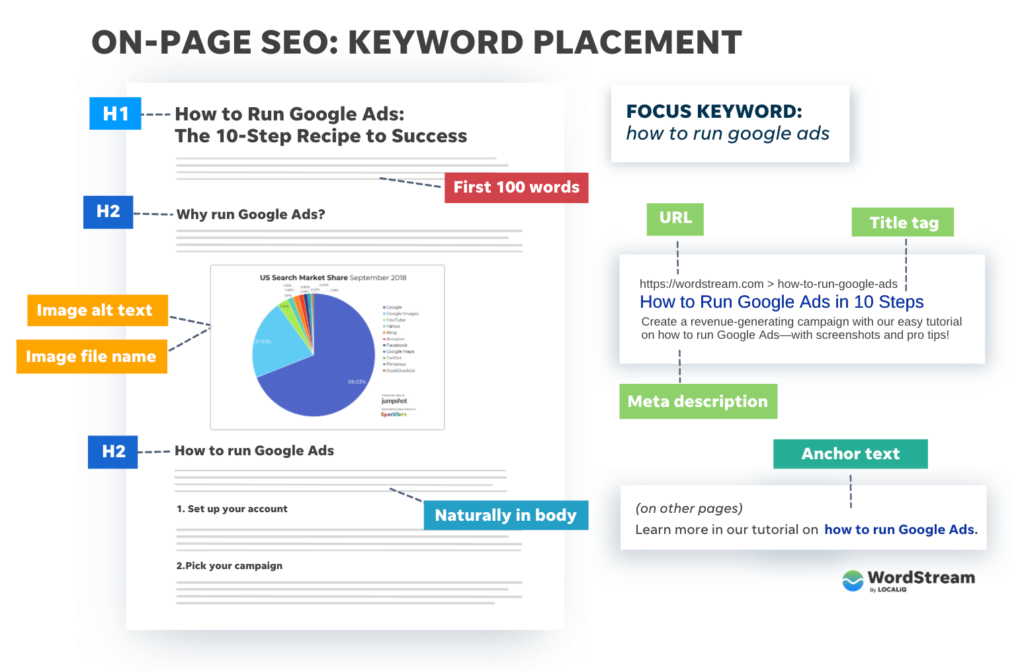
As we enter the new year, businesses must ensure that their website is optimized for search engines. No matter how good your content is, your chances of conversion stand at a minimum if it is not getting visibility with the right audience.
A comprehensive SEO audit can help identify any issues hindering a website’s performance and provide recommendations for improvement. This blog will cover the top considerations for maximizing your search visibility in 2023 with an SEO audit.
What is an SEO audit?
An SEO audit evaluates a website’s search engine optimization (SEO) performance and identifies any areas for improvement. Its ultimate aim is to improve a website’s ranking in search engine results and drive more relevant traffic to the site.

An SEO analysis typically includes a thorough technical SEO audit and an analysis of on-page SEO, and off-page SEO.
An SEO audit can provide several clear benefits for a website, including
1. Improved search engine rankings
An SEO website audit can help it rank higher in search engine results by identifying and fixing technical and on-page SEO issues. This can lead to increased organic traffic and a higher return on investment for the website.

2. Increased website traffic
As a website’s search engine rankings improve, organic traffic will likely increase from users searching for relevant keywords. This can lead to more leads and sales for the website.
3. Better user experience
An SEO audit can help identify usability issues hindering a website’s performance. A website audit can provide a better experience for users by fixing these issues, leading to increased engagement and conversions.
4. Competitive advantage
An SEO analysis can help a website identify and fix issues causing it to underperform compared to its competitors. A website can gain a competitive advantage in search results by improving its SEO performance.
5. Increased credibility
A well-optimized website is more likely to be perceived as credible and trustworthy by users. This can lead to increased credibility and brand loyalty for the website.
Thus, an SEO audit may seem trivial or time-consuming, but it is crucial for identifying and fixing issues that may hold a website back in the search results. By implementing the recommendations from an SEO audit, a website can improve its search engine rankings, increase traffic, and achieve better overall performance.
The 2023 SEO Audit Process
Now that we have covered what an SEO analysis is and why it is crucial for ranking your website in 2023, let us look at some of the processes that go into a complete SEO audit.
1. Start with a crawl.
Before you can begin your audit, you need to understand your current website structure and content well. The easiest way to do this is to use a website crawler tool. A crawler will visit each page on your website, create a map of all the pages, and gather information about the titles, headings, and content on each page.

Some popular crawler tools include Screaming Frog, DeepCrawl, and Semrush.
2. Conduct a technical SEO audit.
After you have a website map, the next step is to analyze its technical SEO. Technical SEO refers to the underlying infrastructure of your website and how it affects your search engine rankings. Some things to look for include the following:
- XML sitemaps: Make sure you have an XML sitemap that is up-to-date and submitted to Google.
- Robots.txt file: This file tells search engines which pages to crawl and which to ignore. Make sure you are not blocking any crucial pages from being crawled.
- Page speed: Slow page speed can hurt your rankings and user experience. Use a tool like PageSpeed Insights to identify areas for improvement.
- Mobile-friendliness: With more and more users accessing the web on mobile devices, it’s important to ensure your website is mobile-friendly. Use Google’s Mobile-Friendly Test to check.
- HTTPS: Google gives a ranking boost to websites served over HTTPS (Hypertext Transfer Protocol Secure). If your website is not using HTTPS, consider switching.

3. Analyze your website’s content and on-page SEO.
Once you have conducted a technical SEO audit, the next step is to analyze your website’s content and on-page SEO. On-page SEO analysis refers to optimizing individual web pages to rank higher and earn more relevant traffic.
Some things to look for include the following:
- Title tags: Make sure your title tags are unique, relevant, and no longer than 60 characters.
- Meta descriptions: Similar to title tags, meta descriptions should be unique, relevant, and no longer than 160 characters.
- Headings: Use headings (H1, H2, etc.) to organize your content and make it easier for users and search engines to understand.
- Alt text: Use alt text to describe images for users and search engines.
- Internal linking: Use internal links to help search engines understand your website’s structure and pass authority from one page to another.

4. Analyze your website’s off-page SEO
Off-page SEO refers to optimizing signals that happen outside your website, such as backlinks from other websites. Some things to look for include the following:
- Backlinks: Use Ahrefs or Semrush to analyze your backlink profile and identify low-quality or spammy links.
- Social media: Make sure you have a presence on major social media platforms and regularly post and engage with your followers.

5. Create an SEO audit report.
Once you have completed your website audit, the next step is to create a report detailing your findings and recommendations. Creating an SEO audit report can help website owners and marketing teams prioritize their efforts and improve their search engine rankings.

To create an SEO audit report, follow these steps:
- Gather data: The first step in creating an SEO audit report is to gather data about your website’s SEO performance. This can include data about your website’s technical SEO, on-page SEO, off-page SEO, and more. Many SEO audit tools can help you gather this data, such as Google Analytics, Screaming Frog, and Semrush.
- Analyze the data: Once you have collected all your data, the next step is to analyze it and look for any areas that need improvement. This can include identifying technical issues, analyzing the relevance and quality of your website’s content, and examining your backlink profile.
- Create a report: After you have analyzed your data, the next step is to create a report that summarizes your findings and recommends any necessary changes. This report should be organized clearly and concisely, with sections for each aspect of your website’s SEO performance.
- Present the report: You will need to present your report to the relevant parties, such as the website owner or marketing team. Be prepared to answer any questions or concerns during the presentation.
Some key components to include in an SEO audit report are
- Executive summary: A brief overview of the current state of the website’s SEO and the main findings of the audit.
- Technical SEO: A detailed analysis of the website’s technical SEO, including page speed, mobile-friendliness, and HTTPS
- On-page SEO: An analysis of the website’s on-page SEO, including title tags, meta descriptions, headings, and alt text
- Off-page SEO: An analysis of the website’s off-page SEO, including backlinks and social media presence
- Recommendations: A list of actionable recommendations for improving the website’s SEO, prioritized by impact and ease of implementation

In Conclusion
By performing a thorough SEO audit and implementing the recommendations given above, businesses can improve their search engine rankings and drive more relevant traffic to their website. This can lead to increased leads and sales and a better overall user experience.
Don’t wait until it’s too late – start maximizing your search visibility in 2023 with these SEO audit best practices and get a headstart over your competition!
FAQs
An SEO audit is a process of evaluating a website’s performance in search engines, aiming to identify and fix any issues that may be impacting its ranking and visibility. An SEO audit typically involves analyzing a range of on-page and off-page factors, including the website’s content, structure, technical performance, and backlink profile.
An SEO audit is crucial because it helps identify and fix any issues that may impact a website’s ranking and visibility in search results. By conducting an SEO audit, you can identify opportunities to improve the website’s performance in search engines and increase its visibility and traffic.
An SEO audit can identify a range of issues that may impact a website’s ranking and visibility in search engines. Some common issues that an SEO audit can identify include:
1. Keyword stuffing,
2. Duplicate content,
3. Broken links,
4. Slow loading speed
Several tools and techniques can be used to conduct an SEO audit for a website. Some common steps in the process include
1. Analyzing the website’s content and structure,
2. Examining the website’s technical performance,
3. Evaluating the website’s backlink profile
Conducting an SEO audit for your website at least once a year or more frequently if you are making significant changes to the website is recommended. This can help you identify and fix any issues that may be impacting the ranking and visibility of your website in search results.
Latest Blogs
Explore how Google’s 2025 AI search updates triggered ranking chaos. Learn actionable strategies to adapt your SEO for AI Overviews, zero-click searches, and SERP volatility. Stay ahead now.
Learn how to rank on AI search engines like ChatGPT, Perplexity, and Gemini by optimizing your content for authority, structure, and relevance. Stay ahead in AI-driven search with this strategic guide.
Explore the best healthcare SEO services for your medical practice. Improve online visibility and effectively reach more patients in need of your services.
Get your hands on the latest news!
Similar Posts

Content Analytics
8 mins read
Google I/O 2025: AI Search Shake-Up & Ranking Volatility

SEO
5 mins read
Top 10 Agencies for Banking and Financial SEO Services Industry

SEO
4 mins read